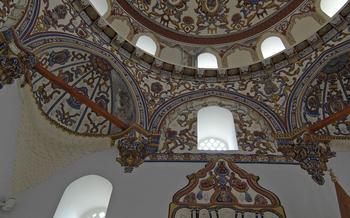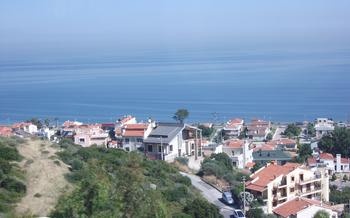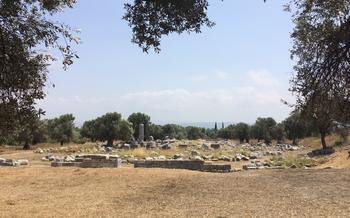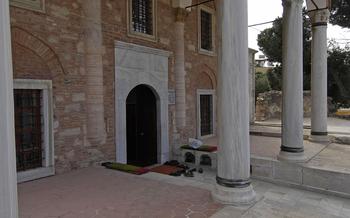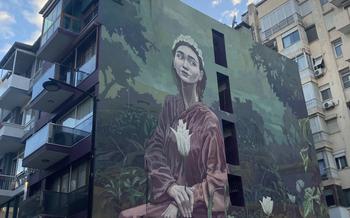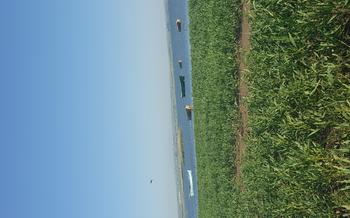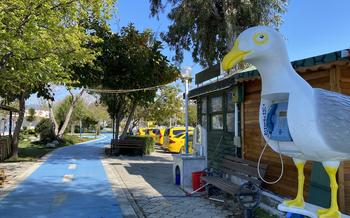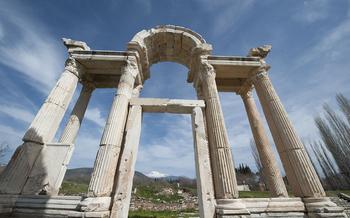
Priene Ancient City
- Historical Background
- Geographical Location
- Architectural Marvels
- Unique Features
- Excavations and Discoveries
- Visiting Priene
- Guided Tours
- Best Time to Visit
- Nearby Attractions
- Accommodation and Dining
- Photography Opportunities
- History Buffs and Architecture Enthusiasts
- Solo Travelers and Small Groups
- Respecting the Site
- Insider Tip
Historical Background
Priene, a city of profound historical significance, was one of the twelve Ionian cities that flourished along the Aegean coast in ancient times. Founded in the 4th century BC by the Greeks, Priene's strategic location on a hilltop overlooking the Aegean Sea and the fertile valley below made it a thriving center of trade and culture.
During the Hellenistic period, Priene experienced a golden age of prosperity, becoming a prominent center of learning and philosophy. It was home to a renowned school of philosophy founded by Bias of Priene, one of the Seven Sages of Greece. Priene's prosperity continued under Roman rule, but its fortunes declined in the Byzantine era due to earthquakes, wars, and the shifting political landscape.
Today, Priene stands as a testament to the ingenuity and artistry of its ancient builders. The well-preserved ruins, including the city walls, temples, and theater, offer a glimpse into the grandeur and sophistication of this once-thriving metropolis. Ongoing archaeological excavations continue to uncover new insights into Priene's rich history and daily life.
Geographical Location
Priene is a remarkable ancient city situated in the İzmir province of Turkey, nestled along the picturesque coastline of the Aegean Sea. Its strategic location in antiquity was of great significance, as it served as a gateway to the Aegean region and beyond. Priene lies in close proximity to other prominent ancient cities, including Miletus, Ephesus, and Didyma, forming a cultural and historical nexus in ancient Ionia. Moreover, Priene's acropolis offers breathtaking views of the surrounding mountains and the sparkling Aegean Sea, inviting visitors to immerse themselves in the natural beauty that complements the city's rich history.
Architectural Marvels
The ruins of Priene showcase an impressive blend of Greek and Roman architectural influences, providing a glimpse into the city's rich history. The well-preserved city walls, gates, and towers offer a testament to the ancient urban planning and fortifications. Among the most notable structures is the Temple of Athena Polias, an iconic landmark with its majestic columns standing tall against the backdrop of the Aegean Sea. Other significant buildings include the agora, the center of public life, the theater, used for performances and assemblies, and the bouleuterion, where the city council convened. These architectural marvels stand as a testament to the skill and ingenuity of the ancient builders and provide a fascinating glimpse into the urban landscape of Priene.
Unique Features
Priene is renowned for its unique urban layout, showcasing a grid-like pattern of streets and blocks that has become a hallmark of Hellenistic city design. This layout, known as the "Hippodamian" plan, was named after the Greek architect Hippodamus of Miletus, who is credited with its development. The city's streets intersect at right angles, dividing the city into regular blocks or insulae, each containing residential or public buildings.
This grid-like layout was not only aesthetically pleasing but also served practical purposes. It facilitated efficient movement of people and goods, ensured proper drainage, and provided a sense of order and organization to the city. The "Hippodamian" plan was widely adopted in other Hellenistic cities, becoming a defining feature of urban planning in the ancient world.
Priene's water management system was another remarkable feat of engineering. The city had an elaborate aqueduct that brought water from a nearby spring, ensuring a steady supply for its inhabitants. The aqueduct was constructed using stone and terracotta pipes, and its remains can still be seen today. The city also had a sophisticated system of cisterns, which stored rainwater for use during dry spells or in case of emergencies.
Excavations and Discoveries
Priene has been the subject of extensive archaeological excavations since the late 19th century, led by teams from various institutions, including the German Archaeological Institute and the University of Mimar Sinan. These excavations have unearthed a wealth of artifacts and structures that have shed light on the city's history, daily life, and cultural practices.
Significant discoveries include well-preserved sculptures, inscriptions, and pottery fragments. These artifacts provide valuable insights into the artistic and cultural traditions of Priene's inhabitants. Among the most notable finds are the marble statue of Athena Polias, the patron goddess of the city, and the "Nike of Priene," a bronze statue depicting the goddess of victory.
Excavations have also revealed the remains of public buildings, such as the bouleuterion (council chamber) and the gymnasium. The discovery of these structures highlights the importance of civic life and physical activity in ancient Priene. The ongoing excavations continue to uncover new insights into the city's past, making Priene a valuable site for archaeological research and exploration.
Visiting Priene
To reach Priene from İzmir, you can take a direct bus or rent a car. The journey by bus takes approximately 5 hours, while driving takes about 1 hour and 45 minutes. Once in Priene, the ancient city site is easily accessible on foot from the main road.
The site is open to visitors daily from 8 am to 6 pm. Admission fees are minimal and can be paid at the entrance. It is recommended to wear comfortable clothing and sturdy footwear, as the terrain can be uneven and dusty. During hot summer months, a hat and sunscreen are essential.
Picnic areas are available within the ancient city, so visitors can bring their own snacks and drinks. Alternatively, there are local restaurants and cafes in the nearby village of Güllübahçe, where you can enjoy traditional Turkish cuisine and fresh seafood.
Guided Tours
Enhance your visit to Priene by taking advantage of a guided tour. Led by knowledgeable guides, these tours provide an immersive experience that brings the ancient city to life. With their expertise, guides can offer insights into the history, architecture, and significance of the ruins, helping you make the most of your visit. They can point out hidden details, share stories about the people who lived here, and explain the cultural and historical context of the site. Guided tours are especially beneficial for first-time visitors or those seeking a deeper understanding of Priene. Booking a tour in advance is recommended, particularly during peak tourist season, to secure a spot and avoid disappointment. Whether you're a history buff, an architecture enthusiast, or simply someone curious about the past, a guided tour of Priene is an excellent way to gain a deeper appreciation for this remarkable ancient city.
Best Time to Visit
Timing your visit to Priene is crucial to ensure a pleasant and enriching experience. The ideal time to explore this ancient city is during the shoulder seasons, which fall in spring (April-May) and autumn (September-October). During these months, the weather is generally mild and comfortable, with warm days and cool nights. The crowds are also smaller compared to the peak tourist season, allowing you to explore the ruins at your own pace without feeling overwhelmed.
While Priene is accessible year-round, summer months (June-August) can be scorching, with temperatures often exceeding 35 degrees Celsius. The intense heat and crowds can make exploring the ruins less enjoyable. Winter (November-March) brings cooler temperatures and fewer crowds, but some areas of the site may be inaccessible due to rain or snow.
If you're interested in attending special events or festivals, plan your visit accordingly. Priene occasionally hosts cultural events, concerts, and historical reenactments that offer a unique perspective on the city's past. Check local tourism websites or contact the Priene Museum for more information on upcoming events.
Nearby Attractions
Beyond Priene's captivating ruins, the İzmir province boasts a treasure trove of other ancient cities, each with its unique story to tell. Miletus, located just a short distance away, was once a thriving port city and the birthplace of famous philosophers and scientists. Explore its impressive theater, well-preserved city walls, and the renowned Temple of Apollo.
Ephesus, a UNESCO World Heritage Site, is another must-visit destination. Step into the awe-inspiring Library of Celsus, marvel at the Temple of Artemis, and walk along the grand Marble Street. The Great Theater of Ephesus is an architectural masterpiece that once hosted theatrical performances and public gatherings.
Didyma, home to the Oracle of Apollo, is another gem waiting to be discovered. Witness the grandeur of the Temple of Apollo, with its towering columns and intricate carvings. The oracle, once consulted by people from across the ancient world, adds an air of mystery and intrigue to this site.
These ancient cities, interconnected by history and geography, offer a fascinating glimpse into the rich cultural heritage of the region. Combining visits to these sites with your exploration of Priene will provide a comprehensive understanding of the ancient world and its enduring legacy.
Accommodation and Dining
Staying overnight near Priene allows you to soak up the atmosphere of this ancient city and explore it at a more leisurely pace. Several accommodation options are available in the nearby town of Söke, ranging from budget-friendly guesthouses to comfortable hotels. For a truly immersive experience, consider booking a room at a traditional Turkish guesthouse, where you can enjoy warm hospitality and savor delicious local cuisine.
When it comes to dining, Söke offers a variety of restaurants and cafes catering to different tastes and budgets. Indulge in traditional Turkish dishes like kebabs, mezes, and freshly caught seafood at local eateries. For a memorable dining experience, head to one of the charming restaurants with outdoor seating, where you can enjoy your meal while taking in the views of the surrounding countryside. For those who prefer a picnic lunch, designated areas within the ancient city provide a tranquil setting to savor your packed treats amidst the ruins.
Photography Opportunities
Priene offers a treasure trove of photographic opportunities for visitors with a keen eye for capturing the beauty of ancient ruins and natural landscapes. The well-preserved ruins provide a stunning backdrop for photography, with every corner offering a unique perspective. From the towering columns of the Temple of Athena Polias to the intricate carvings on the city walls, there are endless subjects to capture.
For panoramic views, head to the acropolis, where you can capture breathtaking shots of the surrounding mountains, the Aegean Sea, and the ancient city spread out below. The golden hour, just before sunset, is an ideal time to visit Priene for photography, as the warm light casts a magical glow on the ruins.
To capture the grandeur of the ruins and the surrounding landscape, consider using a wide-angle lens. This will allow you to fit more elements into your frame and create stunning compositions. Experiment with different angles and perspectives to find unique and creative shots that showcase the beauty of Priene.
Whether you're a professional photographer or simply an enthusiast with a smartphone, Priene is a photographer's paradise waiting to be explored. Don't forget to share your stunning captures with the world and inspire others to discover the wonders of this ancient city.
History Buffs and Architecture Enthusiasts
Priene is an absolute must-see destination for history buffs and architecture enthusiasts. As a remarkably well-preserved example of ancient urban planning and architecture, it offers a glimpse into the sophisticated world of the ancient Greeks and Romans. The city's ruins showcase a fascinating blend of Greek and Roman influences, with impressive city walls, gates, towers, and a majestic temple dedicated to Athena Polias.
By exploring Priene, visitors can gain valuable insights into the architectural styles and techniques that shaped the ancient world. The unique grid-like pattern of streets and blocks, known as the "Hippodamian" plan, is a testament to the advanced urban planning principles employed by the ancient Greeks. Additionally, the well-preserved public buildings, including the agora, theater, and bouleuterion, provide a glimpse into the civic and social life of ancient Priene.
Whether you're a seasoned history buff or simply fascinated by ancient architecture, Priene is a treasure trove of discoveries that will leave you in awe. Prepare to be transported back in time as you walk through the ruins of this once-thriving city, marveling at the ingenuity and artistry of its ancient builders.
Solo Travelers and Small Groups
Priene is a welcoming destination for solo travelers and small groups. The site is safe and easy to navigate, and there are plenty of opportunities to learn about its history and culture. Joining a guided tour or hiring a private guide is a great way to maximize your experience and gain valuable insights into the ruins. However, if you prefer to explore at your own pace, you can wander through the streets and admire the well-preserved structures at your leisure. Priene is a place where you can truly immerse yourself in the past and connect with the people who lived here centuries ago. So, whether you're a solo traveler seeking adventure or a small group looking for a unique cultural experience, Priene is an excellent choice.
Respecting the Site
Priene is a living testament to history, and it is crucial to respect and preserve this ancient site for future generations. As visitors, we have a responsibility to treat the ruins with care and consideration. Refrain from touching or damaging any structures, as they are fragile and irreplaceable. Remember that Priene is an active archaeological site, and ongoing excavations may require visitors to be mindful of restricted areas. Please respect the work of archaeologists and stay within designated pathways to avoid disturbing their research. By being respectful and mindful, we can help ensure that Priene remains a source of wonder and knowledge for years to come.
Insider Tip
-
Embrace the Magic of Sunset: Experience the enchantment of Priene during the golden hour of sunset. As the sun dips below the horizon, the ancient ruins are bathed in a warm, ethereal light, creating a magical ambiance. Capture this fleeting moment with your camera to immortalize the beauty of Priene in a unique and unforgettable way.
-
Venture Beyond the Main Ruins: While the main attractions of Priene are undoubtedly captivating, don't miss the opportunity to explore the lesser-visited areas of the site. Discover the residential quarters, where you can imagine the daily lives of the ancient inhabitants. These hidden gems offer a glimpse into the domestic architecture and urban planning of Priene, providing a more comprehensive understanding of this remarkable ancient city.
